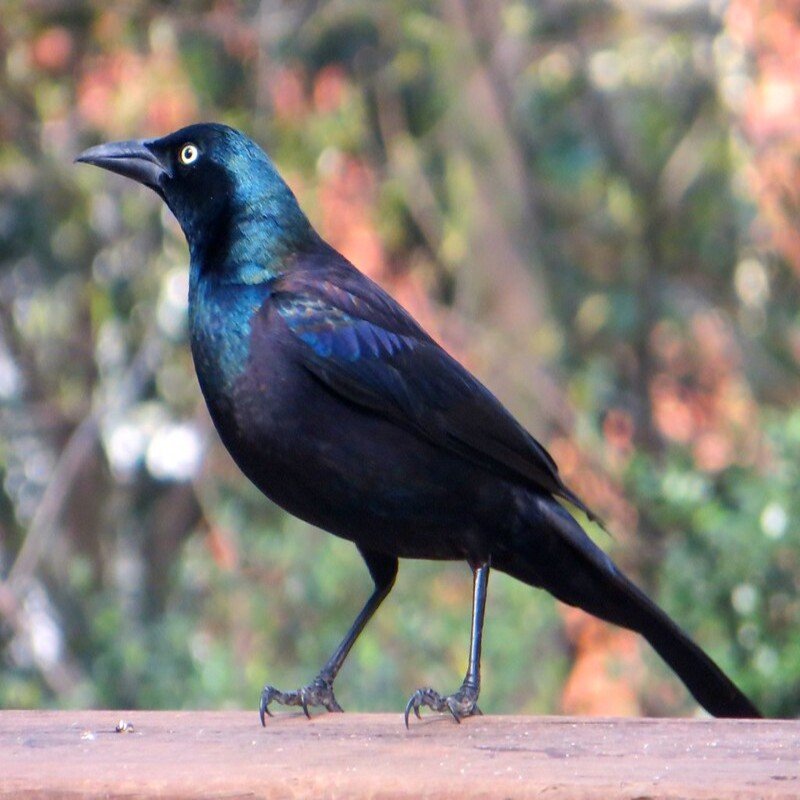Quiscalus quiscula is a big icterid found across North America. Carl Linnaeus named three subspecies of the common grackle in 1758. Adult common grackles have a long tail and a black beak. Male adults, notably, have iridescent heads. Common grackles are located east of the Rocky Mountains.
Quick Overview: Quiscalus Guiscula – Common Grackle
Body size: Around 11-13.5 in (28-34cm) and a weight of 128 g (4.5 oz)
Main colors: Bluish-blue, Purple-blue, Bronze, Purple, Green, Black,
Range: North and Eastern Part of United States
Migratory Bird: Yes
Best time of the year to see in the U.S.:All Year (January – December)
Conservation Status: Least Concern
Common Grackle Description
These are medium-sized blackbirds. Their black plumage is lustrous and shiny. Its bluish-blue or purple-blue heads, necks, and breasts are lustrous. However, common grackles vary in hue across North America. In New England and the West, the subspecies are bronze-colored. The body is purple east of the Allegheny Mountains, and the feathers are greenish. Graceless is black with golden eyes. Long, keel-shaped tails.

Size
These birds have a length of 11-13.5 in (28-34cm) and a weight of 128 g (4.5 oz). Their wings could range from 17-18.5 in (43-47 cm).
Feeding
Grackles eat mostly insects and other invertebrates during reproducing. The diet includes goldfish, minnows, crayfish, tiny frogs, salamanders, mice, and small bats. Grackles feed on agricultural grains and seeds, especially maize and acorns, throughout migration and winter. They consume fruit.
Habitat
This species an opportunistic forager, following plows in quest of grubs and even eating human rubbish. Adults steal earthworms from eating robins. Foraging on the ground is preferred by grackles, but they also use trees and plants.
Common grackles inhabit open regions with scattered trees (conifers preferred). They inhabit fields, orchards, and marshes. In open settings like suburban developments, municipal parks, and cemeteries, common grackles have adapted well to human buildings. In reality, human change of wooded ecosystems for agriculture has increased the range and population of common grackles.
Behavior
Crows are sociable. Non-incubating grackles roost together at night during the mating season. They include red-winged blackbirds, European starlings, and brown-headed cowbirds. Breeding pairs nest alone or in colonies of up to 200. Although gregarious birds, grackles attack each other. They bite, peck, scrape and fly toward other birds. These birds also eat other birds’ eggs and nestlings as well as adult house sparrows. Grackles are alone around the nest. Pairs crowd, pursue, or dive at predators, including people. A flock of the aforementioned species.
Quiscalus Guiscula Scientific Classification
- Kingdom: Animalia
- Phylum: Chordata
- Subphylum: Chelicerata
- Class: Aves
- Order: Passerifomes
- Family: Icteridae
- Genus: Quiscalus
- Species: Quiscalus quiscula
Best time of the year to see
In the United States, the best time of year to see these birds is all year round, regardless of the season. This refers to any month of the year between January and December.
Distribution of the Common Grackle in the USA
Breeds across North America east of the Rocky Mountains and south of the tundra, albeit it is found only during the summer months in the northern sections of its range. From southern New England and Minnesota south to the Gulf Coast, this species is a resident.
The Common Grackle can be found in the following states in the United States – Alabama, Alaska, Arizona, Arkansas, California, Colorado, Connecticut, Delaware, Florida, Georgia, Hawaii, Idaho, Illinois, Indiana, Iowa, Kansas, Kentucky, Louisiana, Maine, Maryland, Massachusetts, Michigan, Mississippi, Missouri, Montana, Nebraska, Nevada, New Hampshire, New Jersey, New Mexico, New York, North Carolina, North Dakota, Ohio, Oklahoma, Oregon, Pennsylvania, Rhode Island, South Carolina, South Dakota, Tennessee, Texas, Utah, Vermont, Virginia, Washington, West Virginia, Wisconsin, and Wyoming.
